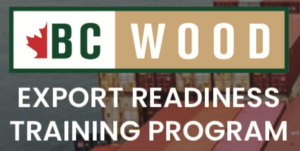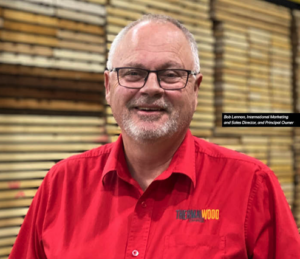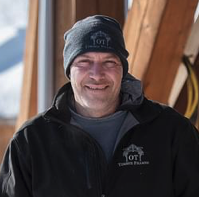 Given increased interest and emphasis on growing and diversifying Canada’s value-added wood exports, the Tree Frog News decided to have a closer look at BC Wood’s Export Readiness Program—which kicked off last week. In an earlier piece, we noted that it appeared well received, based on surveys of past participants. But why were they signing up, what were their key learnings and how have their export plans evolved since? With BC Wood’s blessing we reached out to five individuals who completed the 9-module program in 2021, to learn answers to these and other questions.
Given increased interest and emphasis on growing and diversifying Canada’s value-added wood exports, the Tree Frog News decided to have a closer look at BC Wood’s Export Readiness Program—which kicked off last week. In an earlier piece, we noted that it appeared well received, based on surveys of past participants. But why were they signing up, what were their key learnings and how have their export plans evolved since? With BC Wood’s blessing we reached out to five individuals who completed the 9-module program in 2021, to learn answers to these and other questions.
As background, the program was initiated in 2019 with funding support from BC FII and NRCan. It guides participants through the complete process of exporting in three phases: i) determining export readiness; ii) tactical lessons in research and planning; and iii) dealing with international logistics (trade agreements, finance, virtual selling, etc.). The weekly modules are open to any Canadian company, are delivered virtually, and can be undertaken in whole or part. They’re 1.5 hours each and you can join live (at 8:30 am PST) or listen to one or all of the sessions at your convenience on BC Wood’s YouTube channel (for more information, contact BC Wood’s Randi Walker at rwalker@bcwood.com or 604-309-6683).
As for our interviewees, we spoke in detail with:
 Bob Lennon of Thermalwood Canada, a Bathurst, New Brunswick producer of thermally modified hardwood products for a wide range of indoor and outdoor applications. Launched in 2008, Thermalwood uses heat to stabilize the wood, reduce the risk of decay and insect damage without chemicals, and create a uniform darker colouration.
Bob Lennon of Thermalwood Canada, a Bathurst, New Brunswick producer of thermally modified hardwood products for a wide range of indoor and outdoor applications. Launched in 2008, Thermalwood uses heat to stabilize the wood, reduce the risk of decay and insect damage without chemicals, and create a uniform darker colouration.
 Oli Tritten of OT Timber Frames, a 150 Mile House, British Columbia producer of custom, handcrafted timber frame homes, buildings and timber accent structures. A European, university-trained timber framing professional, Oli worked for Pioneer Log Homes of BC (of Timber Kings fame) for seven years before founding his own fabricating company in 2011.
Oli Tritten of OT Timber Frames, a 150 Mile House, British Columbia producer of custom, handcrafted timber frame homes, buildings and timber accent structures. A European, university-trained timber framing professional, Oli worked for Pioneer Log Homes of BC (of Timber Kings fame) for seven years before founding his own fabricating company in 2011.
Scott Frost of Cedar-Built Greenhouses, an Abbotsford, British Columbia producer of handcrafted, custom ordered, cedar greenhouse kits. A small, family-based company established in 2000, the firm now manufactures and ships over 100 kits annually to all regions of Canada and the United States.
With respect to the motivation behind their decision to sign up for the program, all three representatives immediately referenced Covid-19. However, whereas Lennon and Tritten spoke of the significant uncertainty created by the lockdowns and how sales could be sustained during a pandemic, Frost was focused on Covid’s aftermath. This is because of the DIY/home renovation boom—caused by mitigation measures that created more work and leisure time at home—which drove greenhouse sales up. Frost’s objective was thus to prepare for the likely downturn in sales post-Covid and offset through exports. Other motivators cited by one or more of the participants included their lack of training in how to plan and prepare for the export market, and their past challenges with the “trial and error” approach.
With respect to some of their key takeaways, Lennon referenced the detailed check lists and supporting information, which he now refers to as is “recipe book” and keeps on the side of his desk. Coming from Europe and having done some exporting, Tritten spoke of the helpful reminders in key areas, such as the importance of understanding each country’s market and their relevant cultural sensitivities. Frost noted the picture-perfect fit for him as a value-added wood manufacturer—having look into many other programs, and the clarity gained on challenging topics such as shipping overseas, which was accentuated in real time by the Suez canal crisis. All three participants were highly complementary of the quality of the educators and their course information—”university level” according to Frost—the fact that they engaged directly with all of the participants, and that the one-on-one assistance continued post-session.
With respect to how their export program has evolved, Lennon referenced the considerable efforts undertaken to narrow his target markets, and prepare and execute his export plan. Although no new export sales had yet been secured, a prominent lead was progressing and Lennon was confident sales would follow. Tritten was equally optimistic about his future export growth but had paused his efforts pending less restrictive travel restrictions; and Frost was simply too busy filling current orders to pursue offshore sales. However, he said, “if and when a post-Covid sales-slowdown happens, I’m now well prepared”.
Bottom line, it’s clear the program gave added value to these value-added wood manufacturers, whether they’re looking to survive and grow through covid or in its aftermath.
